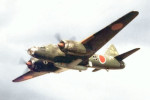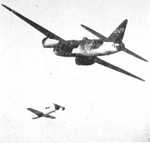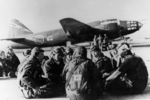MXY7 Ohka
| Country | Japan |
| Manufacturer | Yokosuka Naval Air Technical Arsenal |
| Primary Role | Other |
| Maiden Flight | 23 October 1944 |
Contributor: C. Peter Chen
ww2dbaseIn 1943, Japanese Navy 405th Squadron transport pilot Ensign Mitsuo Ohta submitted a rudimentary design that detailed a purpose-built suicide aircraft. Ohta's design was ignored until spring of 1944 when it was picked up by Professor Taichiro Ogawa of the Aeronautical Research Institute of the University of Tokyo, who refined Ohta's design. The Japanese Navy did not pay official attention to it until Jun 1944 when Japan was defeated in the Mariana Islands. The idea that originated by Ohta was given to the Naval Air Technical Arsenal at Yokosuka, and the new research project which officially began on 16 Aug 1944 under codename Project Marudai under Commander Masao Yamana. The aircraft was given the nickname of Ohka, "Cherry Blossom". The original plan was to use KR-10 liquid-fuel rocket engines which were being built in Nagasaki based on German Walther rocket engine plans, but ultimately the engineers changed to using solid rocket boosters due to cost and complexity concerns. The first unpowered prototypes and K-1 training versions were completed in early Sep 1944; later in the same month, the testing of rocket engines began in parallel. On 23 Oct 1944, the first unmanned flight took place over Sagami Bay southwest of Tokyo; 8 days later, the first manned flight using a K-1 training aircraft was conducted. The first successful test of a rocket-powered Ohka Type 11 took place on 19 Nov 1944, which led to the formal authorization of production under the designation MXY7. While each of the prototypes had three fuselage-mounted rocket boosters and two wing-mounted rocket boosters, the production version was to only have the three fuselage-mounted rocket boosters.
ww2dbaseIn Sep 1944, the Japanese Navy 721st Squadron "Divine Thunder Unit" (Jinrai Butai) was formed under Captain Motoharu Okamura based at Konoike airfield, Ibaraki, Japan to begin training of already-experienced pilots for flights of the aircraft that were soon to be known as MXY7 Ohka rocket-assisted glide bombs. The 722nd Squadron "Torpedo" (Tatsumaki) was planned to be formed, but personnel reserved for this squadron ultimately became replacements for the 721st Squadron. The first 50 Ohka Type 11 aircraft were delivered to carrier Shinano in Nov 1944, but they were lost when Shinano was torpedoed and sunk in transit on 28 Nov. This and other general shipping delays caused by the American blockade caused operations of this new weapon to be held up until 21 Mar 1945; on this date, the 321st Squadron's first combat sortie from Kanoya airfield at Kyushu, Japan resulted in failure, with most aircraft of the attack force (18 G4M2 bombers of 711th Squadron under Lieutenant Commander Goro Nonaka carrying 16 Ohka aircraft, and 30 escorting A6M5 fighters) shot down before reaching the target American fleet. Japanese naval leadership decided that future Ohka missions were to be dispatched in much smaller groups to avoid detection.
ww2dbaseEarlier in the same month, on 8 Mar, US intelligence first detected the new Ohka aircraft at Konoike airfield and gave the name "Viper" for the new discovery. On 1 Apr 1945, an Ohka mission was launched off Okinawa, Japan and damaged USS West Virginia; on the same day, a cache of 15 Ohka aircraft was captured by the United States Marines on Okinawa, who nicknamed them baka, Japanese for "fool", as the discovery was made on April Fool's Day.
ww2dbaseOn 12 Apr, a combat sortie saw destroyer USS Mannert L. Abele being struck by an Ohka aircraft shortly after the same ship was struck by a special attack fighter off Okinawa, Japan; as the destroyer broke in half and sank, she became the first ship to be sunk by an Ohka attack. Two days later, 7 G4M bombers approached American ships off Okinawa, but all were shot down before they were able to launch their Ohka payloads. On 16 Apr, an Ohka attack off Okinawa by six G4M bombers resulted in failure. On 28 Apr, four G4M bombers attacked yet again using the Ohka weapon but without success. On 4 May and 11 May, another two attacks damaged a minesweeper and a destroyer. The final Ohka attack took place on 22 Jun, with all six Ohka aircraft missing their targets. Americans on the receiving end of the attacks reported that, as the Ohka aircraft entered their final approaches, ie. with the rocket boosters engaged, they were nearly unstoppable due to the fast speed.
ww2dbaseIn early 1945, Model 21 variant design was being developed, with smaller warhead (only 600 kilograms, half the size of that mounted on Model 11 production variant aircraft) and shorter wingspan so that these new Ohka aircraft could be mounted under the smaller and faster P1Y1 Ginga bombers; Model 21 efforts were canceled before any prototypes were created. Another variant design, Model 22, was developed starting in 15 Feb 1945 with the Hitachi Tsu-11 jet engine being the intended source of propulsion. The first drop test of Ohka Model 22 was conducted on 26 Jun 1945 in failure, with the aircraft exploding in an in-flight accident. On 12 Aug, another flight test was scheduled, but was canceled in-flight due to an immature ignition of the jet engine. Only a few Model 22 aircraft were built before the war ended. Finally, the Ohka Model 33 (with Ne-20 turbojet engine) and Model 43 (capable of independent flight) variant designs were also being developed. Model 33 efforts were canceled before completion, while Model 43 completed on 26 Apr 1945. The construction of the launch base for Model 43 aircraft began in Jul 1945 on the Miura Peninsula south of Tokyo and a wooden prototype was tested there in Aug 1945 shortly before the war ended.
ww2dbaseUltimately, Model 11, the original production variant, was the only variant design that saw combat. 755 Ohka Model 11 aircraft (155 at Yokosuka and 600 at Kasumigaura), 45 K-1 training aircraft, and about 40 to 50 prototypes of various variant designs were built.
ww2dbaseSource:
Steven Zaloga, Kamikaze: Japanese Special Attack Weapons 1944-45
Last Major Revision: Sep 2011
MXY7 Ohka Timeline
| 16 Aug 1944 | The Naval Air Technical Arsenal at Yokosuka, Japan formally began the development of the aircraft that would later be known as the Ohka. |
| 23 Oct 1944 | The first unmanned flight of the prototype Ohka aircraft was conducted over Sagami Bay, Japan. |
| 31 Oct 1944 | The first manned flight of the prototype Ohka aircraft was conducted; the aircraft was equipped with two wing-mounted rockets and no fuselage-mounted rockets. |
| 19 Nov 1944 | The first successful test of a rocket-powered Ohka aircraft was conducted, leading to the formal authorization of production. |
| 15 Feb 1945 | The Ohka Model 22 variant design efforts began. |
| 8 Mar 1945 | US intelligence first detected the new Ohka aircraft at Konoike airfield, Japan and nicknamed them "Viper". |
| 21 Mar 1945 | The Japanese made the first operational sortie with the Yokosuka Ohka (Cherry Blossom) suicide aircraft. The sixteen Mitsubishi G4M2e bombers of 321st Squadron launched aircraft were intercepted short of their target and were forced to jettison their piloted weapons. |
| 1 Apr 1945 | An Ohka special attack mission was launched and damaged USS West Virginia off Okinawa, Japan; on the same day, a cache of 15 Ohka aircraft was captured by the United States Marines on Okinawa, who nicknamed them baka, Japanese for "fool", as the discovery was made on April Fool's Day. |
| 14 Apr 1945 | Seven G4M bombers approached American ships off Okinawa, but all were shot down before they were able to launch their Ohka payloads. |
| 16 Apr 1945 | The Japanese Navy launched an Ohka combat sortie off Okinawa by six G4M bombers that resulted in failure. |
| 26 Apr 1945 | The Ohka Model 43 variant design efforts completed. |
| 28 Apr 1945 | Japanese special attack aircraft damaged 5 destroyers, 2 hospital ships, and victory ship Bozeman Victory off Okinawa, Japan. None of the four G4M bombers carrying Ohka special attack aircraft hit their targets. |
| 22 Jun 1945 | The final Japanese Navy Ohka combat sortie was conducted with six G4M bombers; none hit. |
| 26 Jun 1945 | The Ohka Model 22 variant design saw its first drop test; it was a failure, with the aircraft exploding in an in-flight accident. |
| 12 Aug 1945 | The Ohka Model 22 variant design's second test flight was launched but canceled mid-flight due to an immature ignition of the jet engine. |
SPECIFICATIONS
Model 11
| Machinery | Three Type 4 Mark 1 Model 20 rocket motors Solid propellant, 587 pound-force each |
| Armament | 1x1,200kg ammonal warhead |
| Crew | 1 |
| Span | 5.12 m |
| Length | 6.06 m |
| Height | 1.16 m |
| Wing Area | 6.00 m² |
| Weight, Empty | 440 kg |
| Weight, Loaded | 2,140 kg |
| Speed, Maximum | 1,040 km/h |
| Speed, Cruising | 804 km/h |
| Range, Maximum | 36 km |
Photographs
 |  |  |  |
Did you enjoy this article or find this article helpful? If so, please consider supporting us on Patreon. Even $1 per month will go a long way! Thank you. Share this article with your friends: Stay updated with WW2DB: |
Visitor Submitted Comments
9 Mar 2015 05:32:59 AM
March 21, 45' Oka raid: Led by fliers from USS Hornet... Lt. Jim Pearce took the first pics of the "strange" appendage hanging under the Betty's fuselage. All were shot down.
All visitor submitted comments are opinions of those making the submissions and do not reflect views of WW2DB.
» Planned Tokko Aircraft Production, 1945
- » 1,150 biographies
- » 337 events
- » 44,024 timeline entries
- » 1,242 ships
- » 350 aircraft models
- » 207 vehicle models
- » 375 weapon models
- » 123 historical documents
- » 260 facilities
- » 470 book reviews
- » 28,620 photos
- » 431 maps
Joachim von Ribbentrop, German Foreign Minister, Aug 1939
Please consider supporting us on Patreon. Even $1 a month will go a long way. Thank you!
Or, please support us by purchasing some WW2DB merchandise at TeeSpring, Thank you!
7 Dec 2011 01:07:50 PM
The following Baka account was shown to me from the log of the USS Stanly by Bob Alexander. Bob was a Gunner's Mate 1st Class and was given a commendation for firing on the second Baka. I'm writing this on 12/07/11 and Bob's memory of the action is quite good.
------------------------------------
At 1449 diving out of a melee on our starboard boom, an unidentified plane
out-ran our Combat Air Patrol and was taken under fire by 5” battery and automatic weapons as it approached on a collision course. The plane, although hit by automatic fire, crashed into our starboard bow, frame
23, about five feet above the water line, parts of it passing through the ship and continuing through the port side. A large explosion of the port bow at this time seemed to indicate that a bomb exploded there
after passing through the ship. The plane, as sketched in enclosure (E), was approximately 20 feet long, had a 15 foot wing span and no engine or propeller was observed. Remains of a pilot were found in compartment A-302-L with the wreckage. Our speed at this time was 30 knots. At 1458
while we were maneuvering radically another dog-fight was going on high on our starboard quarter, and two Nips were shot out of the sky by our CAP. Suddenly a plane appeared out of nowhere low on our starboard beam.
He closed us so rapidly that he was taken under fire by automatic weapons only. Many hits were observed, and a small section of his wing was shot away as he passed over the ship just aft of #2 stack, ripping our ensign. As we took him under fire to port he attempted to bank but hit the water 2,000 to 3,000 yards off our port bow, bounced once, hit the water again, and disintegrated. This was another engine less, propeller less plane, similar to the one that crashed into the ship. The speed of both planes was estimated to be in excess of 500 knots, and
only a “swishing” was heard.